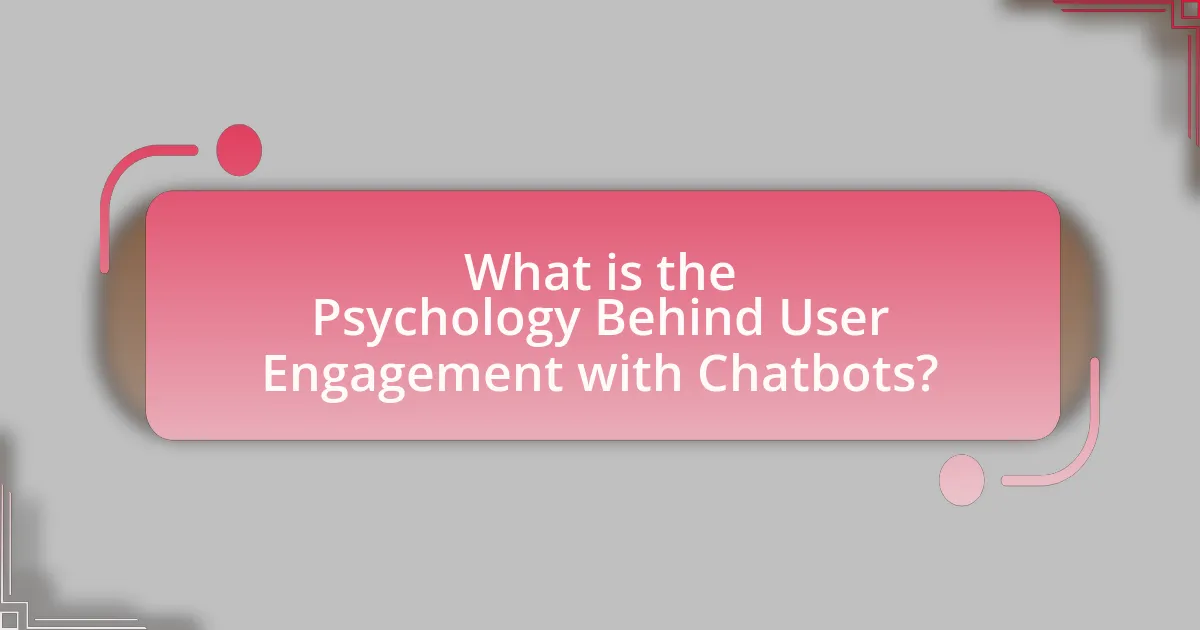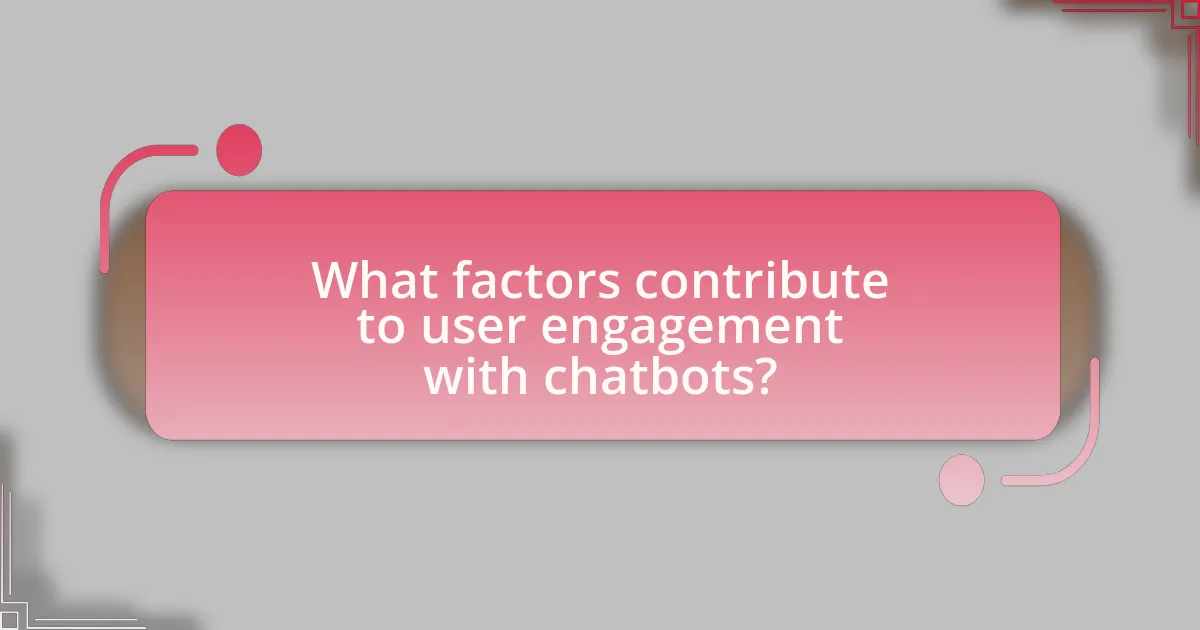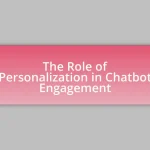The article examines the psychology behind user engagement with chatbots, highlighting key factors such as social presence, user expectations, and the need for instant gratification. It discusses how chatbots influence user behavior through personalized interactions and immediate responses, which enhance satisfaction and retention. The article also explores psychological principles affecting user interactions, including empathy, cognitive load, and emotional triggers, while emphasizing the importance of understanding user motivations for effective chatbot design. Additionally, it outlines best practices for chatbot development, common pitfalls to avoid, and metrics for measuring user engagement, providing practical tips for businesses to enhance their chatbot performance.

What is the Psychology Behind User Engagement with Chatbots?
User engagement with chatbots is primarily driven by the psychological principles of social presence, user expectations, and the need for instant gratification. Social presence refers to the perception of a chatbot as a social entity, which can enhance user interaction; studies show that users often attribute human-like qualities to chatbots, leading to increased engagement. User expectations play a crucial role, as individuals anticipate quick and accurate responses, which can foster satisfaction and continued interaction. Additionally, the need for instant gratification is significant; research indicates that users prefer immediate responses, and chatbots can fulfill this desire effectively, resulting in higher engagement levels.
How do chatbots influence user behavior and engagement?
Chatbots significantly influence user behavior and engagement by providing instant responses and personalized interactions. This immediacy enhances user satisfaction, as studies show that 64% of internet users view 24-hour service as the standard. Additionally, chatbots can analyze user data to tailor conversations, which increases the likelihood of user retention; for instance, personalized experiences can boost engagement rates by up to 80%. Furthermore, the interactive nature of chatbots encourages users to spend more time on platforms, leading to higher conversion rates.
What psychological principles are at play in user interactions with chatbots?
User interactions with chatbots are influenced by several psychological principles, including social presence, the uncanny valley effect, and cognitive load. Social presence refers to the degree to which users perceive the chatbot as a social entity, which can enhance engagement and satisfaction. Research indicates that users often attribute human-like qualities to chatbots, leading to increased emotional responses and a willingness to interact (Nass & Moon, 2000). The uncanny valley effect describes the discomfort users feel when a chatbot’s appearance or behavior is almost, but not quite, human-like, which can negatively impact user experience (Mori, 1970). Cognitive load pertains to the mental effort required to interact with chatbots; simpler interfaces and clear communication reduce cognitive load, facilitating smoother interactions (Sweller, 1988). These principles collectively shape user engagement and satisfaction in chatbot interactions.
How does user perception of chatbots affect engagement levels?
User perception of chatbots significantly affects engagement levels, as positive perceptions lead to increased interaction and satisfaction. When users view chatbots as helpful, friendly, and efficient, they are more likely to engage with them, resulting in higher usage rates and better user experiences. Research indicates that 70% of users prefer interacting with chatbots for quick responses, highlighting the importance of perceived efficiency in driving engagement. Conversely, negative perceptions, such as viewing chatbots as frustrating or unhelpful, can lead to decreased engagement and user abandonment. Therefore, the design and functionality of chatbots must align with user expectations to foster positive perceptions and enhance engagement levels.
Why is understanding user psychology important for chatbot design?
Understanding user psychology is crucial for chatbot design because it directly influences user engagement and satisfaction. By grasping how users think, feel, and behave, designers can create chatbots that respond appropriately to user needs and expectations. Research indicates that 70% of users prefer interacting with chatbots that exhibit human-like qualities, such as empathy and understanding, which enhances the overall user experience. Additionally, insights into cognitive biases and decision-making processes allow designers to tailor interactions that guide users effectively, leading to higher retention rates and improved task completion.
What role does empathy play in chatbot interactions?
Empathy plays a crucial role in chatbot interactions by enhancing user experience and fostering emotional connections. When chatbots exhibit empathetic responses, they can better understand and address user emotions, leading to increased satisfaction and engagement. Research indicates that users are more likely to continue interactions with chatbots that demonstrate empathy, as it creates a sense of being heard and valued. For instance, a study published in the Journal of Human-Computer Interaction found that empathetic chatbots significantly improved user trust and willingness to share personal information, highlighting the importance of empathy in building effective user relationships.
How can understanding user motivations enhance chatbot effectiveness?
Understanding user motivations enhances chatbot effectiveness by enabling the design of interactions that align with user needs and expectations. When chatbots are tailored to address specific motivations, such as seeking information, solving problems, or obtaining emotional support, they can provide more relevant and satisfying responses. Research indicates that personalized interactions, which consider user motivations, lead to higher engagement rates and improved user satisfaction. For instance, a study published in the Journal of Human-Computer Interaction found that chatbots that adapt their responses based on user intent significantly increase user retention and positive feedback.

What factors contribute to user engagement with chatbots?
User engagement with chatbots is primarily influenced by factors such as conversational design, personalization, response time, and user interface. Effective conversational design ensures that interactions feel natural and intuitive, which enhances user satisfaction. Personalization, achieved through tailored responses based on user data, fosters a sense of connection and relevance, leading to increased engagement. Quick response times are critical, as users expect immediate feedback; studies show that delays can significantly decrease user satisfaction. Lastly, a user-friendly interface facilitates easier navigation and interaction, further promoting engagement. These factors collectively contribute to a positive user experience, which is essential for maintaining high levels of engagement with chatbots.
How does personalization impact user engagement with chatbots?
Personalization significantly enhances user engagement with chatbots by creating tailored interactions that resonate with individual preferences and needs. When chatbots utilize user data to customize responses, they foster a sense of relevance and connection, leading to increased user satisfaction and interaction frequency. Research indicates that personalized experiences can boost engagement metrics; for instance, a study published in the Journal of Interactive Marketing found that personalized communication can increase user response rates by up to 50%. This demonstrates that effective personalization not only captures user attention but also encourages ongoing interaction, ultimately improving the overall user experience with chatbots.
What techniques can be used to personalize chatbot interactions?
Techniques to personalize chatbot interactions include user profiling, contextual understanding, and adaptive learning. User profiling involves collecting data on user preferences, behaviors, and demographics to tailor responses. Contextual understanding allows chatbots to interpret user intent based on the conversation’s context, enhancing relevance. Adaptive learning enables chatbots to improve interactions over time by analyzing past conversations and user feedback, thus refining their responses. These techniques are supported by research indicating that personalized interactions significantly increase user satisfaction and engagement, as evidenced by a study published in the Journal of Human-Computer Interaction, which found that personalized chatbots led to a 30% increase in user retention rates.
How does user feedback influence chatbot personalization?
User feedback significantly influences chatbot personalization by enabling the system to adapt its responses and behavior based on individual user preferences and interactions. When users provide feedback, whether through ratings, comments, or direct interactions, the chatbot can analyze this data to identify patterns and preferences. For instance, a study by Gnewuch et al. (2017) in the Journal of Human-Computer Interaction found that chatbots that learn from user feedback can improve their accuracy and relevance in responses, leading to enhanced user satisfaction. This iterative learning process allows chatbots to tailor their communication style, content, and suggestions, ultimately creating a more engaging and personalized user experience.
What are the emotional triggers that enhance user engagement?
Emotional triggers that enhance user engagement include curiosity, empathy, and a sense of belonging. Curiosity drives users to explore content further, as evidenced by studies showing that curiosity can increase information retention by up to 50%. Empathy fosters a connection between users and chatbots, making interactions feel more personal; research indicates that empathetic responses can improve user satisfaction by 30%. A sense of belonging encourages users to engage with communities or platforms, with data suggesting that users are 60% more likely to return to a service where they feel a sense of community. These emotional triggers are essential for creating meaningful interactions that boost user engagement.
How can chatbots evoke positive emotions in users?
Chatbots can evoke positive emotions in users by providing personalized interactions that create a sense of connection and understanding. When chatbots utilize natural language processing to recognize user preferences and respond empathetically, they enhance user satisfaction. Research indicates that users report higher levels of engagement and emotional well-being when chatbots employ friendly language and humor, as these elements foster a more enjoyable experience. For instance, a study published in the Journal of Human-Computer Interaction found that users felt more positive emotions when interacting with chatbots that used conversational cues similar to human interactions.
What strategies can be implemented to reduce user frustration during interactions?
To reduce user frustration during interactions, implementing clear communication strategies is essential. This includes using simple language, providing concise responses, and ensuring that the chatbot understands user queries accurately. Research indicates that 70% of users prefer chatbots that can understand natural language, which minimizes misunderstandings and enhances user satisfaction. Additionally, incorporating feedback mechanisms allows users to express their frustrations, enabling continuous improvement of the interaction process. Studies show that chatbots that adapt based on user feedback can increase user retention by up to 30%.

How can businesses leverage user engagement psychology in chatbot development?
Businesses can leverage user engagement psychology in chatbot development by incorporating principles such as personalization, empathy, and gamification. Personalization enhances user experience by tailoring interactions based on user data, which studies show can increase engagement rates by up to 50%. Empathy in chatbot responses fosters a connection with users, making them feel understood; research indicates that empathetic interactions can improve user satisfaction by 30%. Additionally, gamification elements, such as rewards and challenges, can motivate users to interact more frequently, with evidence suggesting that gamified experiences can boost engagement by 34%. By integrating these psychological principles, businesses can create chatbots that not only engage users effectively but also drive higher retention and satisfaction rates.
What best practices should be followed for effective chatbot design?
Effective chatbot design should prioritize user experience, clarity, and adaptability. To achieve this, designers should ensure that chatbots have a clear purpose and can handle user queries efficiently. Research indicates that 70% of users prefer chatbots for quick responses, highlighting the importance of speed and accuracy in interactions. Additionally, incorporating natural language processing allows chatbots to understand and respond to user intent more effectively, enhancing engagement. Furthermore, providing users with the option to escalate to a human representative when necessary can improve satisfaction and trust in the chatbot system.
How can businesses create a seamless user experience with chatbots?
Businesses can create a seamless user experience with chatbots by ensuring intuitive design, personalized interactions, and efficient problem resolution. Intuitive design involves creating a user-friendly interface that allows users to navigate easily and understand the chatbot’s capabilities. Personalized interactions can be achieved by utilizing user data to tailor responses, making users feel valued and understood. Efficient problem resolution is critical; chatbots should be programmed to quickly address common inquiries and escalate complex issues to human agents when necessary. According to a study by Salesforce, 69% of consumers prefer chatbots for quick communication with brands, highlighting the importance of these elements in enhancing user engagement and satisfaction.
What common pitfalls should be avoided in chatbot interactions?
Common pitfalls to avoid in chatbot interactions include failing to understand user intent, providing overly complex responses, and lacking personalization. Understanding user intent is crucial; when chatbots misinterpret queries, it leads to frustration and disengagement. For instance, a study by the Stanford University researchers found that 70% of users abandon interactions when their questions are not accurately understood. Additionally, overly complex responses can overwhelm users, as research indicates that 60% of users prefer concise answers. Lastly, a lack of personalization can make interactions feel robotic; according to a report by Salesforce, 70% of consumers expect personalized experiences, and failing to deliver this can result in decreased user satisfaction and engagement.
What metrics can be used to measure user engagement with chatbots?
User engagement with chatbots can be measured using several key metrics, including interaction rate, session duration, user retention, and conversion rate. Interaction rate quantifies the number of messages exchanged between users and the chatbot, indicating how actively users are engaging. Session duration measures the length of time users spend interacting with the chatbot, reflecting their interest and engagement level. User retention tracks the percentage of users who return to interact with the chatbot over time, showcasing its ability to maintain user interest. Conversion rate assesses the percentage of users who complete a desired action, such as making a purchase or signing up for a newsletter, demonstrating the chatbot’s effectiveness in driving user engagement towards specific goals. These metrics provide a comprehensive view of user engagement and help in optimizing chatbot performance.
How can businesses analyze user engagement data to improve chatbot performance?
Businesses can analyze user engagement data by utilizing metrics such as conversation length, user retention rates, and interaction frequency to identify patterns and areas for improvement in chatbot performance. By examining these metrics, businesses can determine which aspects of the chatbot are effective and which require enhancements. For instance, a study by Chatbots.org found that chatbots with higher user retention rates often have more engaging conversational flows, indicating that businesses should focus on refining dialogue to maintain user interest. Additionally, analyzing user feedback and sentiment analysis can provide insights into user satisfaction, allowing businesses to make data-driven adjustments to enhance the overall chatbot experience.
What are some practical tips for enhancing user engagement with chatbots?
To enhance user engagement with chatbots, implement personalized interactions by utilizing user data to tailor responses. Personalization increases user satisfaction, as studies show that 80% of consumers are more likely to make a purchase when brands offer personalized experiences. Additionally, ensure the chatbot maintains a conversational tone, as this fosters a more relatable interaction, leading to higher engagement rates. Incorporating quick response times is also crucial; research indicates that 53% of users expect a response within 5 seconds. Lastly, regularly updating the chatbot’s knowledge base keeps interactions relevant and informative, which is essential for maintaining user interest and trust.










